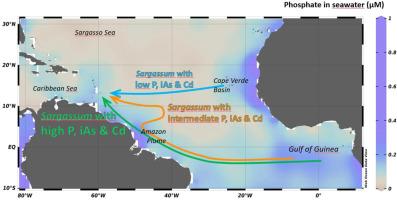圭亚那海流:被砷和镉污染的全壳马尾藻通往加勒比海的快车道
IF 4.5
1区 生物学
Q1 MARINE & FRESHWATER BIOLOGY
引用次数: 0
摘要
迄今为止,关于无机砷(iAs)和镉(Cd)的关键信息几乎没有公布,以帮助管理自2011年以来淹没加勒比海岸的大量远洋马尾藻,并造成重大的环境、健康和经济影响。特别是,经常超过管制水平并限制海藻增值的iAs和Cd的水平没有与来源或途径联系起来。通过分析在瓜德罗普岛和马提尼克岛不同时间收集的大量样本,我们首次强调了一条快速追溯至圭亚那、北巴西和赤道洋流的路线,将马尾藻从赤道带到小安的列斯群岛,耗时3个月。这条有问题的快速通道上的所有马尾藻形态都显示出高水平的iAs和Cd,通常分别超过40 ppm和1 ppm。从佛得角盆地或北巴西反射区带来马尾藻的其他路线较慢,其iAs和Cd含量较低或中等水平。在深入研究了热带大西洋的镉-磷关系后,我们首次概述了马尾藻Cd和P组成的空间差异。本文章由计算机程序翻译,如有差异,请以英文原文为准。

The Guiana current: a fast-lane to the Caribbean for holopelagic Sargassum contaminated in arsenic and cadmium
To date, little key information about inorganic arsenic (iAs) and cadmium (Cd) has been promulgated to help manage the massive influxes of pelagic Sargassum that have inundated the Caribbean coasts since 2011 and are causing significant environmental, health and economic impacts. In particular, the levels of iAs and Cd, which often exceed regulatory levels and limit the seaweed valorization, have not been linked to an origin or route. By analyzing a large number of samples collected at different times in Guadeloupe and Martinique, we have highlighted for the first time a route that rapidly traces back through the Guiana, North-Brazil and equatorial currents, bringing Sargassum to the Lesser Antilles in <3 months from the equator. All the Sargassum morphotypes from this problematic fast track displayed high levels of iAs and Cd, very often exceeding 40 ppm and 1 ppm, respectively. The other routes, which bring Sargassum more slowly, either from the Cape Verde basin or from the North Brazil Retroflection area, have low or intermediate levels of iAs and Cd. Following an in-depth examination of the cadmium-phosphorus relationship in the tropical Atlantic Ocean, we provide here for the first time an overview of the spatial disparities in the Cd and P composition of Sargassum.
求助全文
通过发布文献求助,成功后即可免费获取论文全文。
去求助
来源期刊

Harmful Algae
生物-海洋与淡水生物学
CiteScore
12.50
自引率
15.20%
发文量
122
审稿时长
7.5 months
期刊介绍:
This journal provides a forum to promote knowledge of harmful microalgae and macroalgae, including cyanobacteria, as well as monitoring, management and control of these organisms.
 求助内容:
求助内容: 应助结果提醒方式:
应助结果提醒方式:


